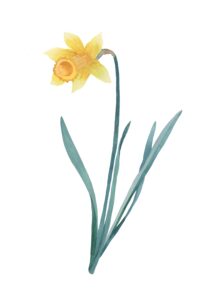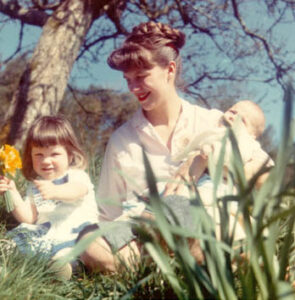 Death, Rebirth, and the Common Daffodil
Death, Rebirth, and the Common Daffodil
By Stevie Gatto (’23)
Content Warning: this post contains references to suicide and death.
Daffodils (Narcissus pseudonarcissus) are often regarded as the trumpets heralding spring, symbolizing life, vigor, and new beginnings. The perennial flowers return year after year, spurred to bloom by the warming spring weather. Daffodils are notably featured in the Smith College annual bulb show, an event showcasing various flowers at Lyman and one that Plath covered in an article for the Daily Hampshire Gazette.
Sylvia Plath had a significant relationship with daffodils, primarily represented through her cultivation and sale of daffodils in the springtime at her home (Court Green) in Devon, England. Plath and her family would pick hundreds of flowers in a single afternoon. Archival documents such as Plath’s letters to various friends and family indicate her time at Court Green was pleasant and enjoyable—a stark contrast to the life events that Plath drew upon to write her famous novel, The Bell Jar. In one letter to her mother, Plath refers to daffodils as “heavenly” in their bloom and gardening them as “soothing & kindly” (Clark 2020: 1410). She was not only a prolific writer at the time, but her botanical hobby was passionate, profitable, and delightfully consuming. Her letters to her mother gushed about the beauty of Court Green, with one exclaiming, “I wouldn’t leave this place for a billion dollars” (Clark 2020: 1423). Plath even compared living with her family amongst the daffodils to “living in Eden” (Clark 2020: 1435).
One of the more famous photographs of Plath (taken by Swedish journalist Siv Arb) depicts Plath and her children in the grass at Court Green, with her daughter clutching a fistful of daffodils as Plath grins. When Plath and her husband (poet Ted Hughes) separated, she left Court Green, and after her passing her husband wrote poetry in memoriam, referencing memories of her picking daffodils.

Plath, her children, and the daffodils at Court Green. Photographed by Siv Arb in April 1962.
Daffodils may be spring blooms that proclaim rebirth, but they are paradoxically also associated with death—both mythologically and physically. Plath was extremely well-read, and she seems to be aware of this paradox. The flower’s botanical name is Narcissus, in reference to the Greek myth of Narcissus. In the story, Narcissus is cursed by the gods to fall in love with his reflection. He is then immobilized by a pool of water, obsessively staring at his reflection until he dies of starvation. When he dies, a daffodil blooms in that same spot. Biologically, too, they have a deadly connotation. A deadly alkaloid in daffodils renders them poisonous, including for neighboring plants, a property known as allelopathy.
Numerous Plath works reference daffodils, and they deploy daffodils in both directions. These include the poem “The Spring Parade,” the short story Mary Ventura and the Ninth Kingdom, and the poem “Berck-Plage.” “The Spring Parade” and Mary Ventura associate daffodils with the traditional meaning of daffodils: a signal of spring and new beginnings. This interpretation aligns with her experience of daffodils at Court Green. “Berck-Plage,” however, points in the opposite direction.
“Berck-Plage,” written during her time at Court Green, was inspired by two memories from Plath’s life, narratively interwoven: first is the titular French seaside resort Plath and her husband vacationed to in 1961 that housed disabled war veterans on the beach; the second is the 1962 death of their Court Green neighbor, Percy Keys, who suffered a fatal illness and whose wife asked Plath and Hughes for assistance in his hospice care.
The poem (one of her longest) is regarded as one of Plath’s most depressing and morbid, as it covers topics such as sickness, death, and decay of the body. “Berck-Plage” is a poem all about death, and the cycle of not only life but memory and mourning. Plath uses daffodils sarcastically, conjuring the imagery of a cheap vase with bright daffodils sitting on a soon-to-be neglected gravestone.
A year after Percy Key’s death and funeral, Plath would take her own life in her London flat. This suicide is often seen as the defining moment of Plath’s life. But would she have seen it this way? Or would she picture daffodils on a beautiful spring day? Death, or rebirth? The end, or the beginning? We can’t ask her, but her letters and poems say enough to guess.
Works Cited
Clark, Heather L. 2020. Red Comet: The Short Life and Blazing Art of Sylvia Plath. New York, NY: Vintage.
Plath, Sylvia. 2018. The Collected Poems. Reprint edition. New York: Harper Perennial Modern Classics.